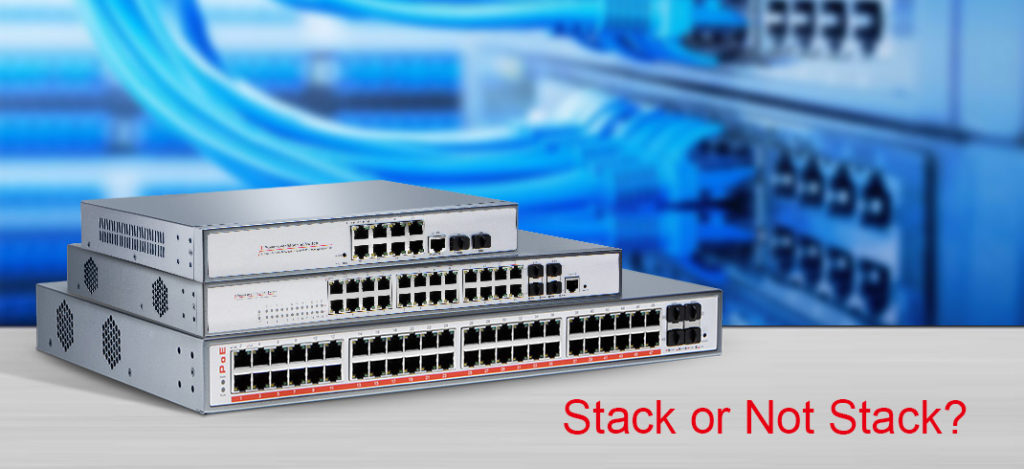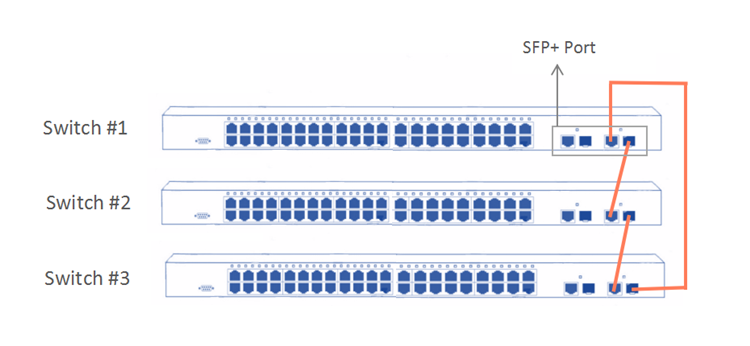When network designers build their networks, there is a common problem that they may meet: whether to stack switches or not. Because limited by the switch port counts, designers have to get more switches or stack switches to meet network build requirements. In the article, the stack of 48 port managed PoE switch will be used as examples to explore how to achieve optimized network performance through switch stacking, and when network designers need to stack their network switches.

How to Decide Whether Switch Stacking Is Need?
Switch stacking is to connect two or a group of network switches to form a single stack unit that can be managed in a simple way. In this way, available switch ports are increasing as well as management simplicity. For example, in a small business network (PoE is necessary), if 48 gigabit ports are needed, two 24-port gigabit PoE switches can be stacked to achieve the target. Of course, one 48 port PoE gigabit switch also can be used. However, whether to choose stacking or not depends on what the designer wants to accomplish. If cost savings and some sense of isolating network outages are important parameters to consider, stacking is a better choice like the two 24-port PoE switches. If features related to simplicity, scalability, and flexibility are more important, then choose the one 48 port PoE switch.
How to Stack 48 Port Managed PoE Switch?
Generally speaking, there are two types of switch stacking—ring topology and chain topology. The main differences are the number of stacking cables used in these two topologies. Furthermore, ring type protects networks from a single failure because communications between the switches continue in a direct way. Chain topology is not a recommended stacking type, for it can cause split stack easily, though it requires less number of cables.
Therefore, the following example is to illustrate how to stack three 48 port managed PoE switches together.

In the picture, all the three 48-port PoE switches are connected via SFP+ port. The connections of SFP+ ports are:
Switch # 1,SFP+ port # 1—Switch # 2, SFP+ port # 2
Switch # 2,SFP+ port # 1—Switch # 3, SFP+ port # 2
Switch # 3,SFP+ port # 1—Switch # 1, SFP+ port # 2
By connecting these switches in this way, a logical progression from port 1 to port 2 is established. This could prevent a single point of failure effectively. At the same time, switches stacking together require more power, which sometimes requires cooling devices. The following video demonstrates how to stack switch by using FS S3900 series switch.
Do You Really Need Switch Stacking?
As network devices growing, more switches are deployed in networks. There are advantages and disadvantages of stackable switches and standalone switches. In fact, whether to need switch stacking depends on how your network is going to be planned today and tomorrow. Standalone switches like FS 48 port switch are beneficial for small business that looks for network efficiency, operational cost savings, and ease of management. While for large enterprise business networks with VoIP traffic and hosting, to simplify management and get more advanced features, stackable switches may be a better choice. If you have problems in selecting a 10G switch, you may read this article: Stackable 10Gbase-T Switch or Standalone 10Gbase-T Switch, Which One Is Better?
Summary
In summary, switch stacking allows network administers to manage several switches as “one switch”, ensuring the performance as well as network management simplification. However, as mentioned above, whether to choose stackable switch depend on the network deployment. Cisco 48 port managed PoE switch usually supports stacking, which is good for large enterprises. While other brand switches like FS 48 port managed PoE switch that doesn’t support stacking is ideal for SMB networks.
Related Article: How to Choose a Suitable 48-Port PoE Switch?